Global Tourism Destinations: Analysis of Key Markets and Trends
VerifiedAdded on 2023/01/19
|17
|4532
|97
Report
AI Summary
This report provides a comprehensive overview of global tourism, examining its scale, nature, and key trends. It delves into the characteristics and growth of emerging markets and destination regions, offering statistical data and analysis of investment, tourist arrivals, and online sales. The report explores the roles of key organizations in global tourism development, highlighting the significance of infrastructure, tourism sites, and generating/receiving areas. Furthermore, it assesses the motivations behind tourism growth and compares emerging international destinations. Finally, the report addresses the threats, issues, and challenges facing the future development of global tourism, providing insights into the industry's evolving landscape and the factors that will shape its future. The report uses data from The Tourism Company, a UK-based consultancy, and various statistical sources to support its findings.
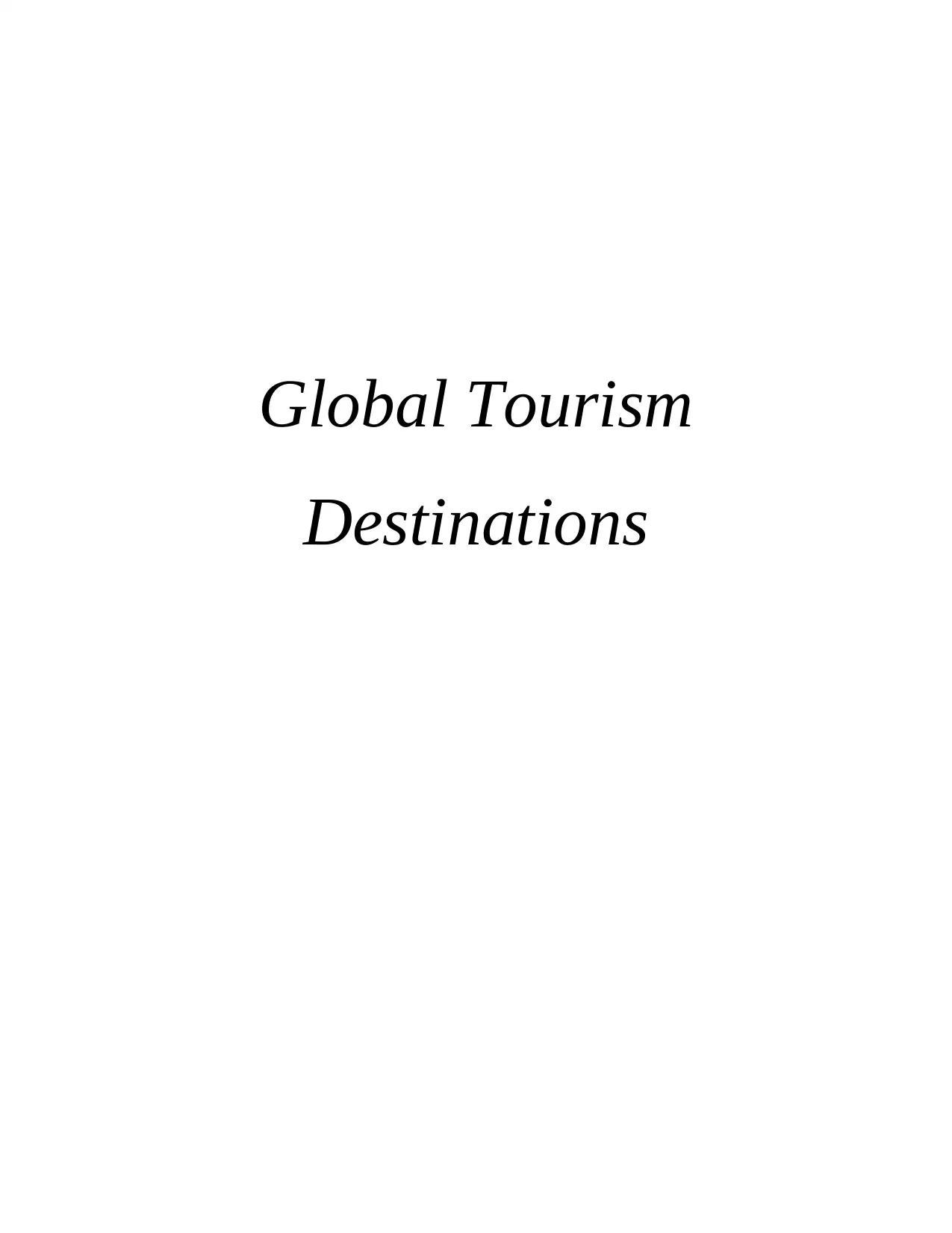
Global Tourism
Destinations
Destinations
Paraphrase This Document
Need a fresh take? Get an instant paraphrase of this document with our AI Paraphraser
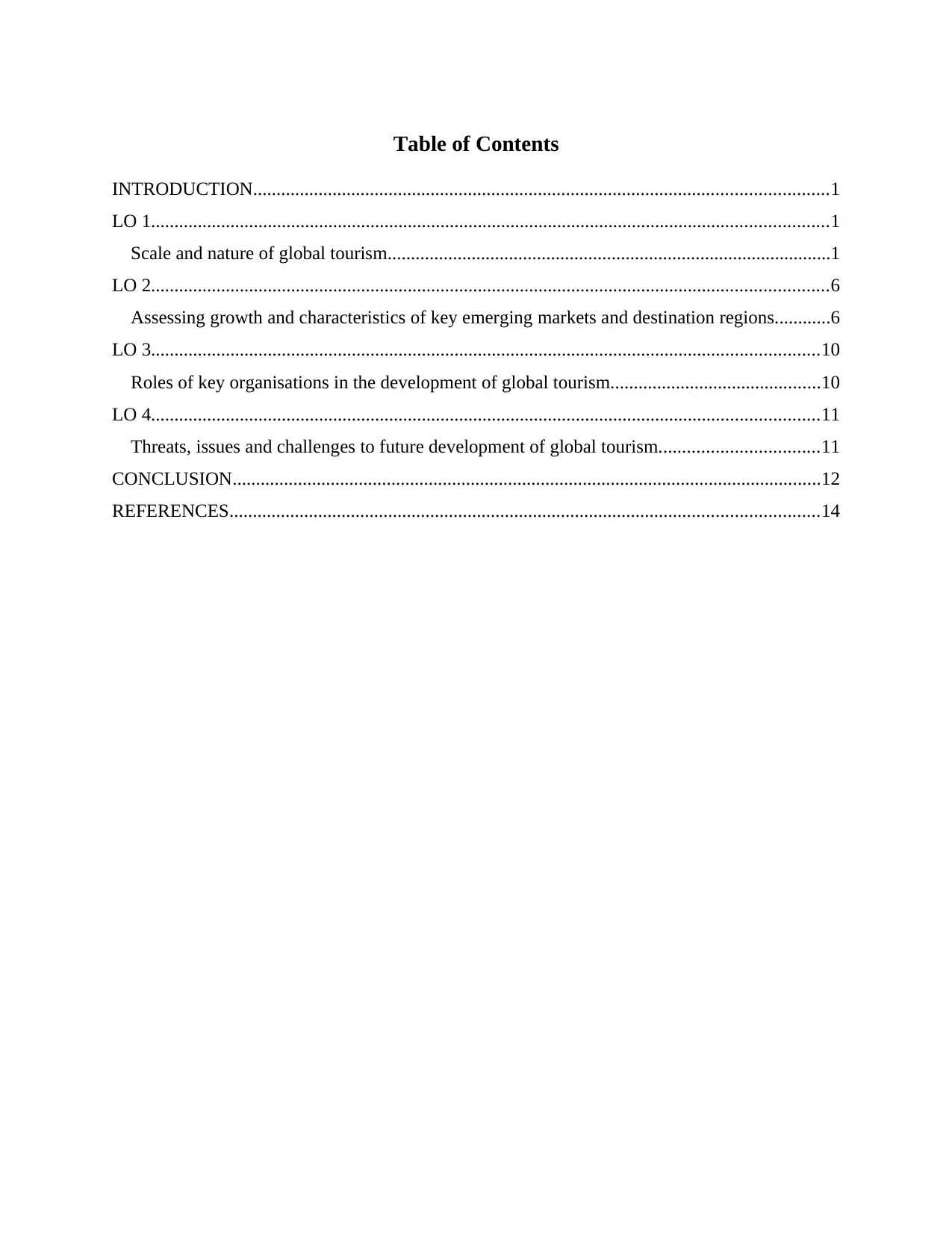
Table of Contents
INTRODUCTION...........................................................................................................................1
LO 1.................................................................................................................................................1
Scale and nature of global tourism...............................................................................................1
LO 2.................................................................................................................................................6
Assessing growth and characteristics of key emerging markets and destination regions............6
LO 3...............................................................................................................................................10
Roles of key organisations in the development of global tourism.............................................10
LO 4...............................................................................................................................................11
Threats, issues and challenges to future development of global tourism..................................11
CONCLUSION..............................................................................................................................12
REFERENCES..............................................................................................................................14
INTRODUCTION...........................................................................................................................1
LO 1.................................................................................................................................................1
Scale and nature of global tourism...............................................................................................1
LO 2.................................................................................................................................................6
Assessing growth and characteristics of key emerging markets and destination regions............6
LO 3...............................................................................................................................................10
Roles of key organisations in the development of global tourism.............................................10
LO 4...............................................................................................................................................11
Threats, issues and challenges to future development of global tourism..................................11
CONCLUSION..............................................................................................................................12
REFERENCES..............................................................................................................................14
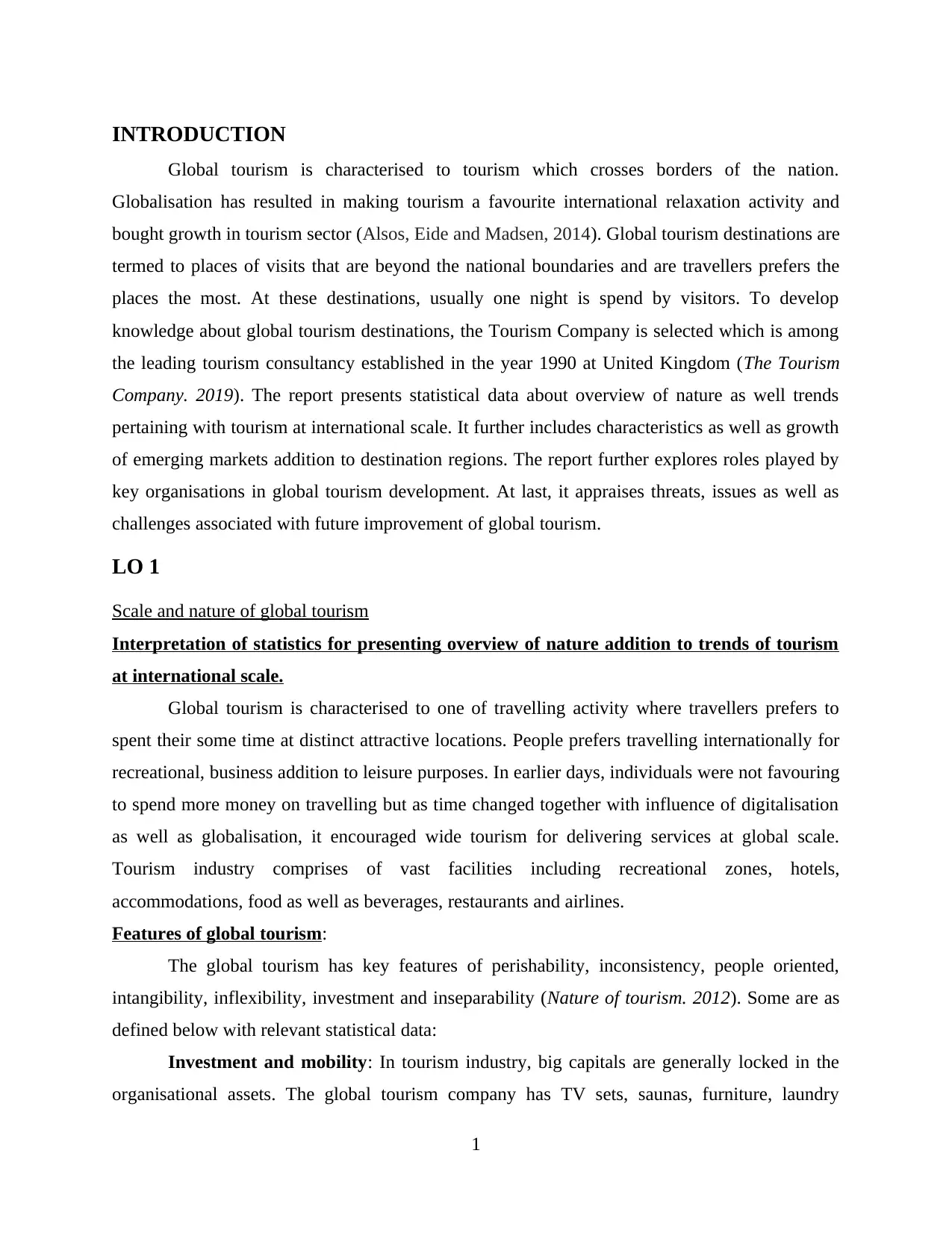
INTRODUCTION
Global tourism is characterised to tourism which crosses borders of the nation.
Globalisation has resulted in making tourism a favourite international relaxation activity and
bought growth in tourism sector (Alsos, Eide and Madsen, 2014). Global tourism destinations are
termed to places of visits that are beyond the national boundaries and are travellers prefers the
places the most. At these destinations, usually one night is spend by visitors. To develop
knowledge about global tourism destinations, the Tourism Company is selected which is among
the leading tourism consultancy established in the year 1990 at United Kingdom (The Tourism
Company. 2019). The report presents statistical data about overview of nature as well trends
pertaining with tourism at international scale. It further includes characteristics as well as growth
of emerging markets addition to destination regions. The report further explores roles played by
key organisations in global tourism development. At last, it appraises threats, issues as well as
challenges associated with future improvement of global tourism.
LO 1
Scale and nature of global tourism
Interpretation of statistics for presenting overview of nature addition to trends of tourism
at international scale.
Global tourism is characterised to one of travelling activity where travellers prefers to
spent their some time at distinct attractive locations. People prefers travelling internationally for
recreational, business addition to leisure purposes. In earlier days, individuals were not favouring
to spend more money on travelling but as time changed together with influence of digitalisation
as well as globalisation, it encouraged wide tourism for delivering services at global scale.
Tourism industry comprises of vast facilities including recreational zones, hotels,
accommodations, food as well as beverages, restaurants and airlines.
Features of global tourism:
The global tourism has key features of perishability, inconsistency, people oriented,
intangibility, inflexibility, investment and inseparability (Nature of tourism. 2012). Some are as
defined below with relevant statistical data:
Investment and mobility: In tourism industry, big capitals are generally locked in the
organisational assets. The global tourism company has TV sets, saunas, furniture, laundry
1
Global tourism is characterised to tourism which crosses borders of the nation.
Globalisation has resulted in making tourism a favourite international relaxation activity and
bought growth in tourism sector (Alsos, Eide and Madsen, 2014). Global tourism destinations are
termed to places of visits that are beyond the national boundaries and are travellers prefers the
places the most. At these destinations, usually one night is spend by visitors. To develop
knowledge about global tourism destinations, the Tourism Company is selected which is among
the leading tourism consultancy established in the year 1990 at United Kingdom (The Tourism
Company. 2019). The report presents statistical data about overview of nature as well trends
pertaining with tourism at international scale. It further includes characteristics as well as growth
of emerging markets addition to destination regions. The report further explores roles played by
key organisations in global tourism development. At last, it appraises threats, issues as well as
challenges associated with future improvement of global tourism.
LO 1
Scale and nature of global tourism
Interpretation of statistics for presenting overview of nature addition to trends of tourism
at international scale.
Global tourism is characterised to one of travelling activity where travellers prefers to
spent their some time at distinct attractive locations. People prefers travelling internationally for
recreational, business addition to leisure purposes. In earlier days, individuals were not favouring
to spend more money on travelling but as time changed together with influence of digitalisation
as well as globalisation, it encouraged wide tourism for delivering services at global scale.
Tourism industry comprises of vast facilities including recreational zones, hotels,
accommodations, food as well as beverages, restaurants and airlines.
Features of global tourism:
The global tourism has key features of perishability, inconsistency, people oriented,
intangibility, inflexibility, investment and inseparability (Nature of tourism. 2012). Some are as
defined below with relevant statistical data:
Investment and mobility: In tourism industry, big capitals are generally locked in the
organisational assets. The global tourism company has TV sets, saunas, furniture, laundry
1
⊘ This is a preview!⊘
Do you want full access?
Subscribe today to unlock all pages.

Trusted by 1+ million students worldwide
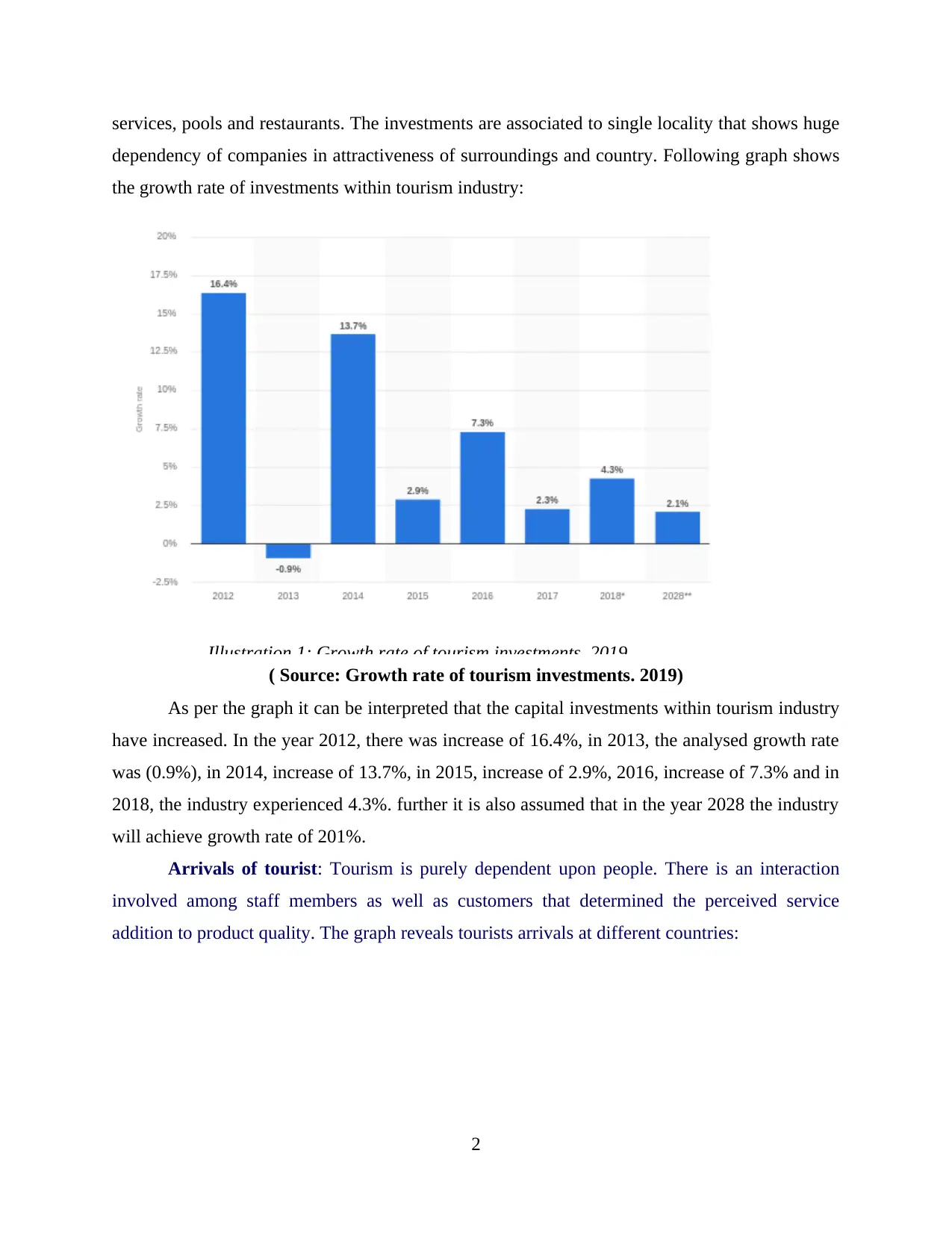
services, pools and restaurants. The investments are associated to single locality that shows huge
dependency of companies in attractiveness of surroundings and country. Following graph shows
the growth rate of investments within tourism industry:
Illustration 1: Growth rate of tourism investments. 2019
( Source: Growth rate of tourism investments. 2019)
As per the graph it can be interpreted that the capital investments within tourism industry
have increased. In the year 2012, there was increase of 16.4%, in 2013, the analysed growth rate
was (0.9%), in 2014, increase of 13.7%, in 2015, increase of 2.9%, 2016, increase of 7.3% and in
2018, the industry experienced 4.3%. further it is also assumed that in the year 2028 the industry
will achieve growth rate of 201%.
Arrivals of tourist: Tourism is purely dependent upon people. There is an interaction
involved among staff members as well as customers that determined the perceived service
addition to product quality. The graph reveals tourists arrivals at different countries:
2
dependency of companies in attractiveness of surroundings and country. Following graph shows
the growth rate of investments within tourism industry:
Illustration 1: Growth rate of tourism investments. 2019
( Source: Growth rate of tourism investments. 2019)
As per the graph it can be interpreted that the capital investments within tourism industry
have increased. In the year 2012, there was increase of 16.4%, in 2013, the analysed growth rate
was (0.9%), in 2014, increase of 13.7%, in 2015, increase of 2.9%, 2016, increase of 7.3% and in
2018, the industry experienced 4.3%. further it is also assumed that in the year 2028 the industry
will achieve growth rate of 201%.
Arrivals of tourist: Tourism is purely dependent upon people. There is an interaction
involved among staff members as well as customers that determined the perceived service
addition to product quality. The graph reveals tourists arrivals at different countries:
2
Paraphrase This Document
Need a fresh take? Get an instant paraphrase of this document with our AI Paraphraser
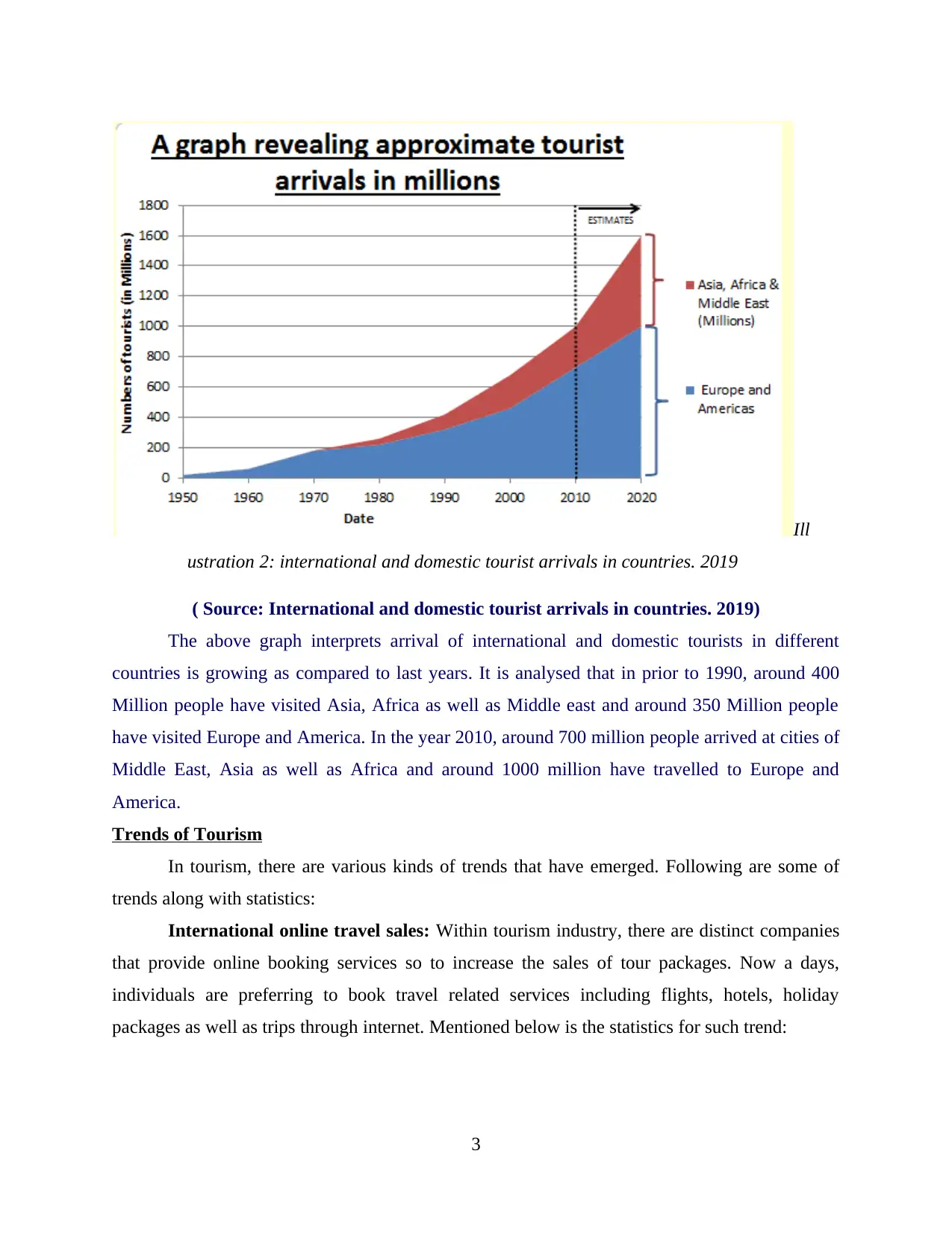
Ill
ustration 2: international and domestic tourist arrivals in countries. 2019
( Source: International and domestic tourist arrivals in countries. 2019)
The above graph interprets arrival of international and domestic tourists in different
countries is growing as compared to last years. It is analysed that in prior to 1990, around 400
Million people have visited Asia, Africa as well as Middle east and around 350 Million people
have visited Europe and America. In the year 2010, around 700 million people arrived at cities of
Middle East, Asia as well as Africa and around 1000 million have travelled to Europe and
America.
Trends of Tourism
In tourism, there are various kinds of trends that have emerged. Following are some of
trends along with statistics:
International online travel sales: Within tourism industry, there are distinct companies
that provide online booking services so to increase the sales of tour packages. Now a days,
individuals are preferring to book travel related services including flights, hotels, holiday
packages as well as trips through internet. Mentioned below is the statistics for such trend:
3
ustration 2: international and domestic tourist arrivals in countries. 2019
( Source: International and domestic tourist arrivals in countries. 2019)
The above graph interprets arrival of international and domestic tourists in different
countries is growing as compared to last years. It is analysed that in prior to 1990, around 400
Million people have visited Asia, Africa as well as Middle east and around 350 Million people
have visited Europe and America. In the year 2010, around 700 million people arrived at cities of
Middle East, Asia as well as Africa and around 1000 million have travelled to Europe and
America.
Trends of Tourism
In tourism, there are various kinds of trends that have emerged. Following are some of
trends along with statistics:
International online travel sales: Within tourism industry, there are distinct companies
that provide online booking services so to increase the sales of tour packages. Now a days,
individuals are preferring to book travel related services including flights, hotels, holiday
packages as well as trips through internet. Mentioned below is the statistics for such trend:
3
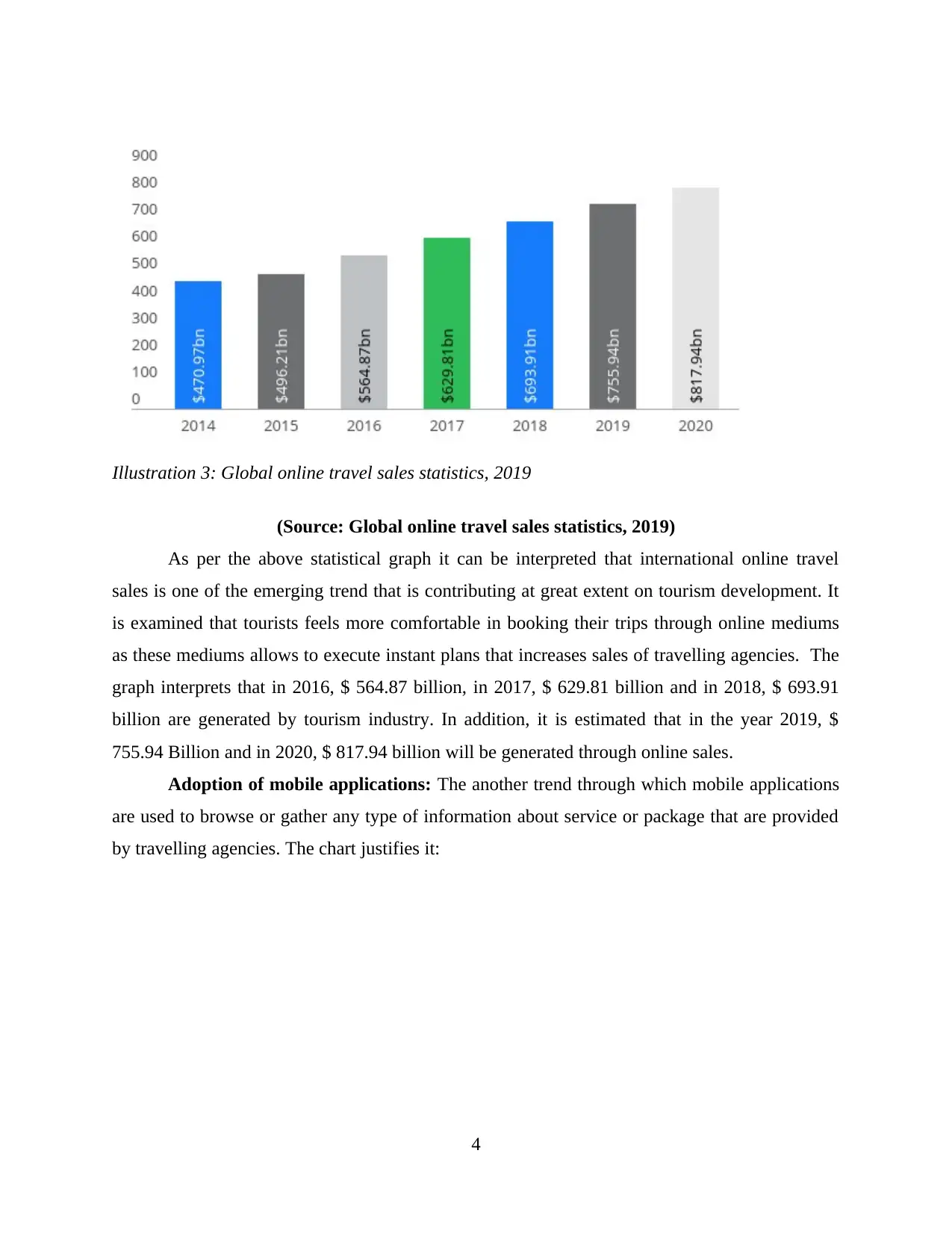
Illustration 3: Global online travel sales statistics, 2019
(Source: Global online travel sales statistics, 2019)
As per the above statistical graph it can be interpreted that international online travel
sales is one of the emerging trend that is contributing at great extent on tourism development. It
is examined that tourists feels more comfortable in booking their trips through online mediums
as these mediums allows to execute instant plans that increases sales of travelling agencies. The
graph interprets that in 2016, $ 564.87 billion, in 2017, $ 629.81 billion and in 2018, $ 693.91
billion are generated by tourism industry. In addition, it is estimated that in the year 2019, $
755.94 Billion and in 2020, $ 817.94 billion will be generated through online sales.
Adoption of mobile applications: The another trend through which mobile applications
are used to browse or gather any type of information about service or package that are provided
by travelling agencies. The chart justifies it:
4
(Source: Global online travel sales statistics, 2019)
As per the above statistical graph it can be interpreted that international online travel
sales is one of the emerging trend that is contributing at great extent on tourism development. It
is examined that tourists feels more comfortable in booking their trips through online mediums
as these mediums allows to execute instant plans that increases sales of travelling agencies. The
graph interprets that in 2016, $ 564.87 billion, in 2017, $ 629.81 billion and in 2018, $ 693.91
billion are generated by tourism industry. In addition, it is estimated that in the year 2019, $
755.94 Billion and in 2020, $ 817.94 billion will be generated through online sales.
Adoption of mobile applications: The another trend through which mobile applications
are used to browse or gather any type of information about service or package that are provided
by travelling agencies. The chart justifies it:
4
⊘ This is a preview!⊘
Do you want full access?
Subscribe today to unlock all pages.

Trusted by 1+ million students worldwide
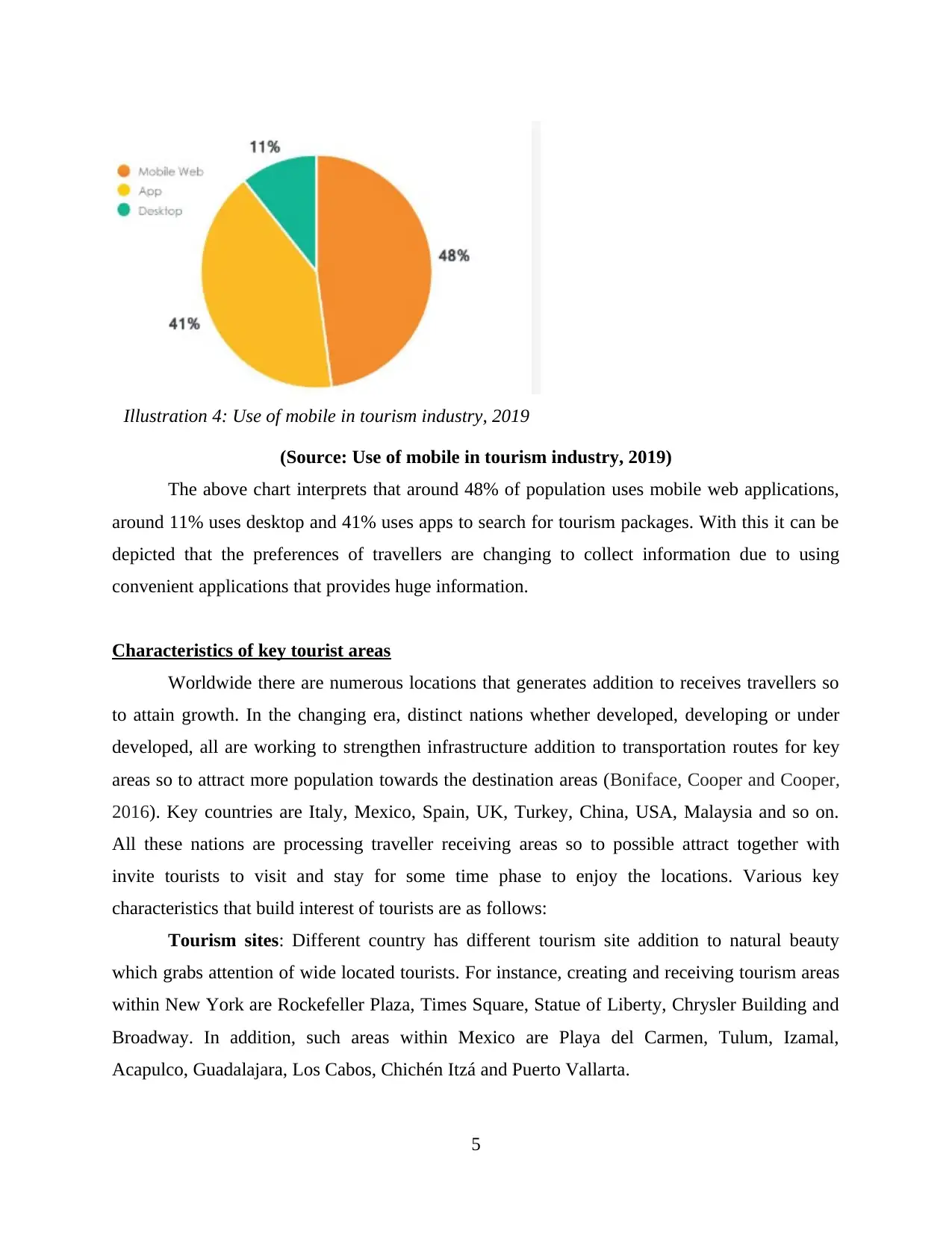
Illustration 4: Use of mobile in tourism industry, 2019
(Source: Use of mobile in tourism industry, 2019)
The above chart interprets that around 48% of population uses mobile web applications,
around 11% uses desktop and 41% uses apps to search for tourism packages. With this it can be
depicted that the preferences of travellers are changing to collect information due to using
convenient applications that provides huge information.
Characteristics of key tourist areas
Worldwide there are numerous locations that generates addition to receives travellers so
to attain growth. In the changing era, distinct nations whether developed, developing or under
developed, all are working to strengthen infrastructure addition to transportation routes for key
areas so to attract more population towards the destination areas (Boniface, Cooper and Cooper,
2016). Key countries are Italy, Mexico, Spain, UK, Turkey, China, USA, Malaysia and so on.
All these nations are processing traveller receiving areas so to possible attract together with
invite tourists to visit and stay for some time phase to enjoy the locations. Various key
characteristics that build interest of tourists are as follows:
Tourism sites: Different country has different tourism site addition to natural beauty
which grabs attention of wide located tourists. For instance, creating and receiving tourism areas
within New York are Rockefeller Plaza, Times Square, Statue of Liberty, Chrysler Building and
Broadway. In addition, such areas within Mexico are Playa del Carmen, Tulum, Izamal,
Acapulco, Guadalajara, Los Cabos, Chichén Itzá and Puerto Vallarta.
5
(Source: Use of mobile in tourism industry, 2019)
The above chart interprets that around 48% of population uses mobile web applications,
around 11% uses desktop and 41% uses apps to search for tourism packages. With this it can be
depicted that the preferences of travellers are changing to collect information due to using
convenient applications that provides huge information.
Characteristics of key tourist areas
Worldwide there are numerous locations that generates addition to receives travellers so
to attain growth. In the changing era, distinct nations whether developed, developing or under
developed, all are working to strengthen infrastructure addition to transportation routes for key
areas so to attract more population towards the destination areas (Boniface, Cooper and Cooper,
2016). Key countries are Italy, Mexico, Spain, UK, Turkey, China, USA, Malaysia and so on.
All these nations are processing traveller receiving areas so to possible attract together with
invite tourists to visit and stay for some time phase to enjoy the locations. Various key
characteristics that build interest of tourists are as follows:
Tourism sites: Different country has different tourism site addition to natural beauty
which grabs attention of wide located tourists. For instance, creating and receiving tourism areas
within New York are Rockefeller Plaza, Times Square, Statue of Liberty, Chrysler Building and
Broadway. In addition, such areas within Mexico are Playa del Carmen, Tulum, Izamal,
Acapulco, Guadalajara, Los Cabos, Chichén Itzá and Puerto Vallarta.
5
Paraphrase This Document
Need a fresh take? Get an instant paraphrase of this document with our AI Paraphraser
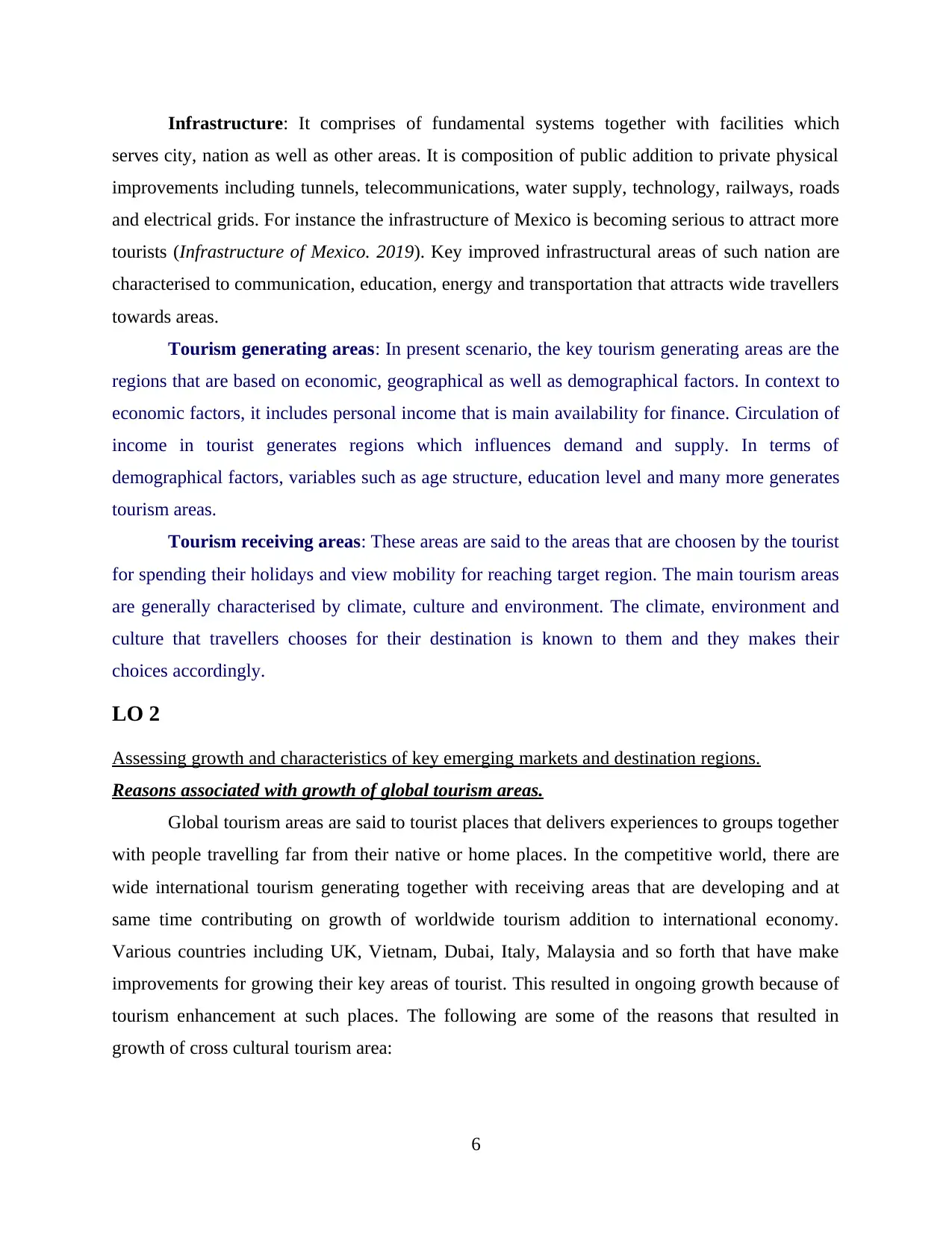
Infrastructure: It comprises of fundamental systems together with facilities which
serves city, nation as well as other areas. It is composition of public addition to private physical
improvements including tunnels, telecommunications, water supply, technology, railways, roads
and electrical grids. For instance the infrastructure of Mexico is becoming serious to attract more
tourists (Infrastructure of Mexico. 2019). Key improved infrastructural areas of such nation are
characterised to communication, education, energy and transportation that attracts wide travellers
towards areas.
Tourism generating areas: In present scenario, the key tourism generating areas are the
regions that are based on economic, geographical as well as demographical factors. In context to
economic factors, it includes personal income that is main availability for finance. Circulation of
income in tourist generates regions which influences demand and supply. In terms of
demographical factors, variables such as age structure, education level and many more generates
tourism areas.
Tourism receiving areas: These areas are said to the areas that are choosen by the tourist
for spending their holidays and view mobility for reaching target region. The main tourism areas
are generally characterised by climate, culture and environment. The climate, environment and
culture that travellers chooses for their destination is known to them and they makes their
choices accordingly.
LO 2
Assessing growth and characteristics of key emerging markets and destination regions.
Reasons associated with growth of global tourism areas.
Global tourism areas are said to tourist places that delivers experiences to groups together
with people travelling far from their native or home places. In the competitive world, there are
wide international tourism generating together with receiving areas that are developing and at
same time contributing on growth of worldwide tourism addition to international economy.
Various countries including UK, Vietnam, Dubai, Italy, Malaysia and so forth that have make
improvements for growing their key areas of tourist. This resulted in ongoing growth because of
tourism enhancement at such places. The following are some of the reasons that resulted in
growth of cross cultural tourism area:
6
serves city, nation as well as other areas. It is composition of public addition to private physical
improvements including tunnels, telecommunications, water supply, technology, railways, roads
and electrical grids. For instance the infrastructure of Mexico is becoming serious to attract more
tourists (Infrastructure of Mexico. 2019). Key improved infrastructural areas of such nation are
characterised to communication, education, energy and transportation that attracts wide travellers
towards areas.
Tourism generating areas: In present scenario, the key tourism generating areas are the
regions that are based on economic, geographical as well as demographical factors. In context to
economic factors, it includes personal income that is main availability for finance. Circulation of
income in tourist generates regions which influences demand and supply. In terms of
demographical factors, variables such as age structure, education level and many more generates
tourism areas.
Tourism receiving areas: These areas are said to the areas that are choosen by the tourist
for spending their holidays and view mobility for reaching target region. The main tourism areas
are generally characterised by climate, culture and environment. The climate, environment and
culture that travellers chooses for their destination is known to them and they makes their
choices accordingly.
LO 2
Assessing growth and characteristics of key emerging markets and destination regions.
Reasons associated with growth of global tourism areas.
Global tourism areas are said to tourist places that delivers experiences to groups together
with people travelling far from their native or home places. In the competitive world, there are
wide international tourism generating together with receiving areas that are developing and at
same time contributing on growth of worldwide tourism addition to international economy.
Various countries including UK, Vietnam, Dubai, Italy, Malaysia and so forth that have make
improvements for growing their key areas of tourist. This resulted in ongoing growth because of
tourism enhancement at such places. The following are some of the reasons that resulted in
growth of cross cultural tourism area:
6
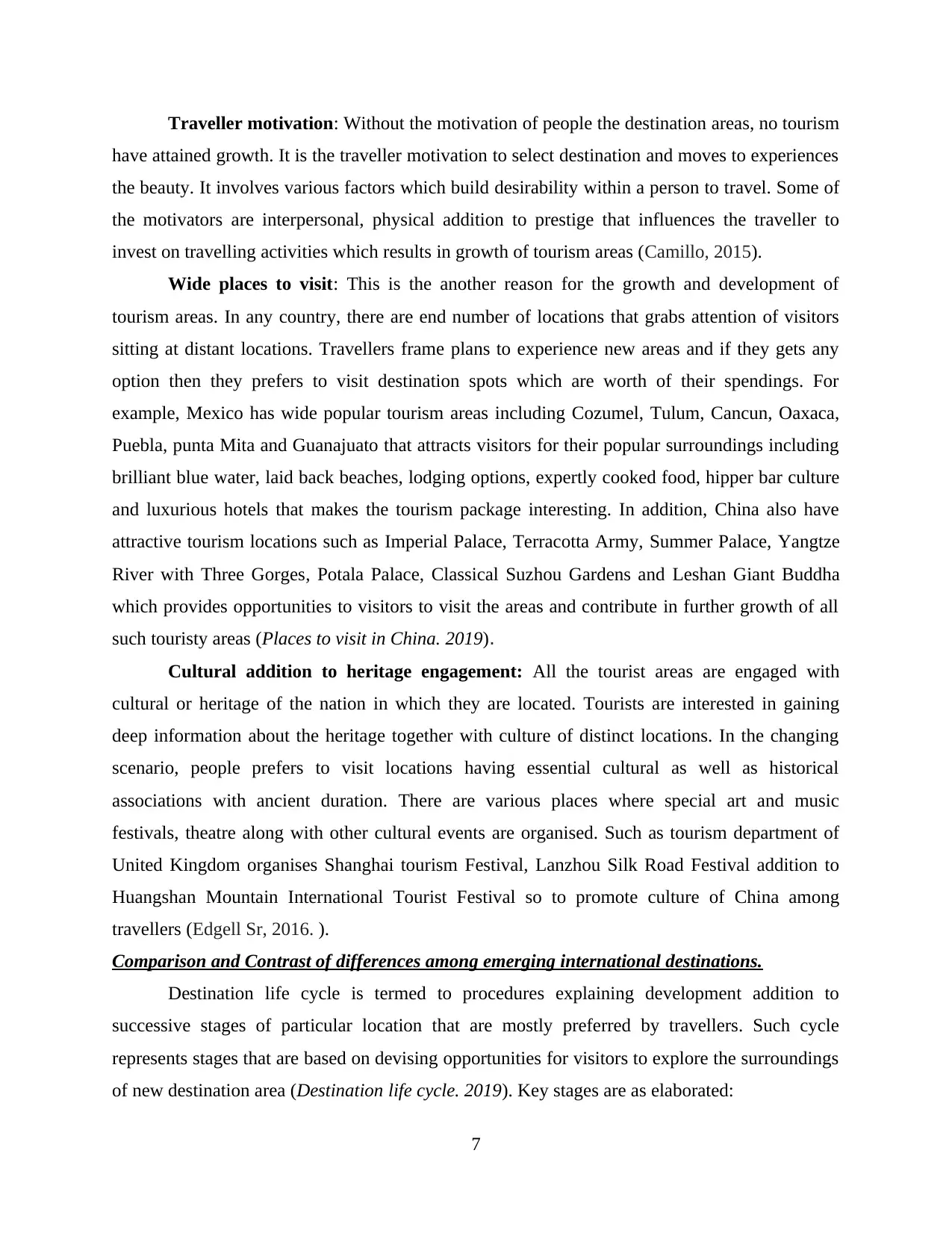
Traveller motivation: Without the motivation of people the destination areas, no tourism
have attained growth. It is the traveller motivation to select destination and moves to experiences
the beauty. It involves various factors which build desirability within a person to travel. Some of
the motivators are interpersonal, physical addition to prestige that influences the traveller to
invest on travelling activities which results in growth of tourism areas (Camillo, 2015).
Wide places to visit: This is the another reason for the growth and development of
tourism areas. In any country, there are end number of locations that grabs attention of visitors
sitting at distant locations. Travellers frame plans to experience new areas and if they gets any
option then they prefers to visit destination spots which are worth of their spendings. For
example, Mexico has wide popular tourism areas including Cozumel, Tulum, Cancun, Oaxaca,
Puebla, punta Mita and Guanajuato that attracts visitors for their popular surroundings including
brilliant blue water, laid back beaches, lodging options, expertly cooked food, hipper bar culture
and luxurious hotels that makes the tourism package interesting. In addition, China also have
attractive tourism locations such as Imperial Palace, Terracotta Army, Summer Palace, Yangtze
River with Three Gorges, Potala Palace, Classical Suzhou Gardens and Leshan Giant Buddha
which provides opportunities to visitors to visit the areas and contribute in further growth of all
such touristy areas (Places to visit in China. 2019).
Cultural addition to heritage engagement: All the tourist areas are engaged with
cultural or heritage of the nation in which they are located. Tourists are interested in gaining
deep information about the heritage together with culture of distinct locations. In the changing
scenario, people prefers to visit locations having essential cultural as well as historical
associations with ancient duration. There are various places where special art and music
festivals, theatre along with other cultural events are organised. Such as tourism department of
United Kingdom organises Shanghai tourism Festival, Lanzhou Silk Road Festival addition to
Huangshan Mountain International Tourist Festival so to promote culture of China among
travellers (Edgell Sr, 2016. ).
Comparison and Contrast of differences among emerging international destinations.
Destination life cycle is termed to procedures explaining development addition to
successive stages of particular location that are mostly preferred by travellers. Such cycle
represents stages that are based on devising opportunities for visitors to explore the surroundings
of new destination area (Destination life cycle. 2019). Key stages are as elaborated:
7
have attained growth. It is the traveller motivation to select destination and moves to experiences
the beauty. It involves various factors which build desirability within a person to travel. Some of
the motivators are interpersonal, physical addition to prestige that influences the traveller to
invest on travelling activities which results in growth of tourism areas (Camillo, 2015).
Wide places to visit: This is the another reason for the growth and development of
tourism areas. In any country, there are end number of locations that grabs attention of visitors
sitting at distant locations. Travellers frame plans to experience new areas and if they gets any
option then they prefers to visit destination spots which are worth of their spendings. For
example, Mexico has wide popular tourism areas including Cozumel, Tulum, Cancun, Oaxaca,
Puebla, punta Mita and Guanajuato that attracts visitors for their popular surroundings including
brilliant blue water, laid back beaches, lodging options, expertly cooked food, hipper bar culture
and luxurious hotels that makes the tourism package interesting. In addition, China also have
attractive tourism locations such as Imperial Palace, Terracotta Army, Summer Palace, Yangtze
River with Three Gorges, Potala Palace, Classical Suzhou Gardens and Leshan Giant Buddha
which provides opportunities to visitors to visit the areas and contribute in further growth of all
such touristy areas (Places to visit in China. 2019).
Cultural addition to heritage engagement: All the tourist areas are engaged with
cultural or heritage of the nation in which they are located. Tourists are interested in gaining
deep information about the heritage together with culture of distinct locations. In the changing
scenario, people prefers to visit locations having essential cultural as well as historical
associations with ancient duration. There are various places where special art and music
festivals, theatre along with other cultural events are organised. Such as tourism department of
United Kingdom organises Shanghai tourism Festival, Lanzhou Silk Road Festival addition to
Huangshan Mountain International Tourist Festival so to promote culture of China among
travellers (Edgell Sr, 2016. ).
Comparison and Contrast of differences among emerging international destinations.
Destination life cycle is termed to procedures explaining development addition to
successive stages of particular location that are mostly preferred by travellers. Such cycle
represents stages that are based on devising opportunities for visitors to explore the surroundings
of new destination area (Destination life cycle. 2019). Key stages are as elaborated:
7
⊘ This is a preview!⊘
Do you want full access?
Subscribe today to unlock all pages.

Trusted by 1+ million students worldwide
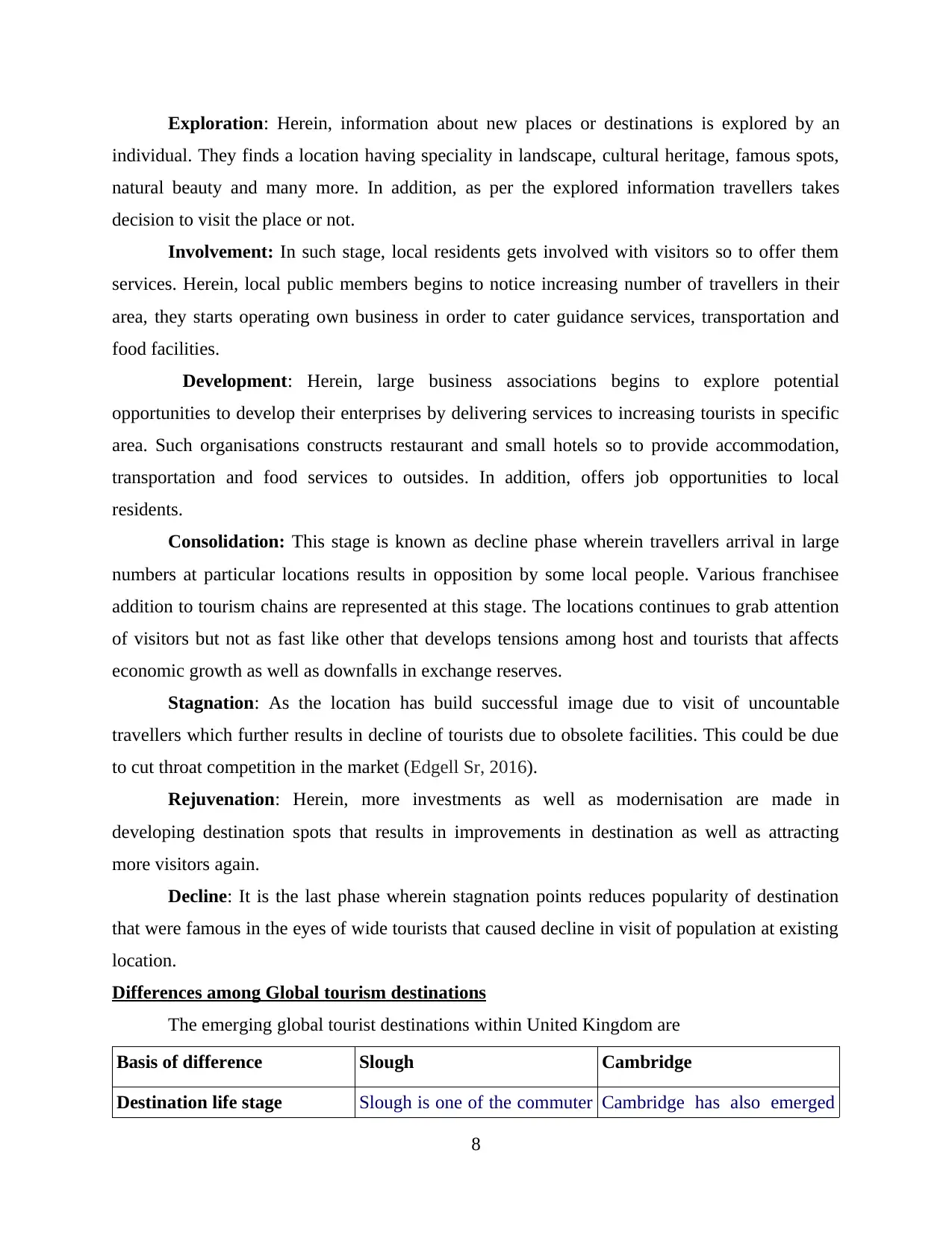
Exploration: Herein, information about new places or destinations is explored by an
individual. They finds a location having speciality in landscape, cultural heritage, famous spots,
natural beauty and many more. In addition, as per the explored information travellers takes
decision to visit the place or not.
Involvement: In such stage, local residents gets involved with visitors so to offer them
services. Herein, local public members begins to notice increasing number of travellers in their
area, they starts operating own business in order to cater guidance services, transportation and
food facilities.
Development: Herein, large business associations begins to explore potential
opportunities to develop their enterprises by delivering services to increasing tourists in specific
area. Such organisations constructs restaurant and small hotels so to provide accommodation,
transportation and food services to outsides. In addition, offers job opportunities to local
residents.
Consolidation: This stage is known as decline phase wherein travellers arrival in large
numbers at particular locations results in opposition by some local people. Various franchisee
addition to tourism chains are represented at this stage. The locations continues to grab attention
of visitors but not as fast like other that develops tensions among host and tourists that affects
economic growth as well as downfalls in exchange reserves.
Stagnation: As the location has build successful image due to visit of uncountable
travellers which further results in decline of tourists due to obsolete facilities. This could be due
to cut throat competition in the market (Edgell Sr, 2016).
Rejuvenation: Herein, more investments as well as modernisation are made in
developing destination spots that results in improvements in destination as well as attracting
more visitors again.
Decline: It is the last phase wherein stagnation points reduces popularity of destination
that were famous in the eyes of wide tourists that caused decline in visit of population at existing
location.
Differences among Global tourism destinations
The emerging global tourist destinations within United Kingdom are
Basis of difference Slough Cambridge
Destination life stage Slough is one of the commuter Cambridge has also emerged
8
individual. They finds a location having speciality in landscape, cultural heritage, famous spots,
natural beauty and many more. In addition, as per the explored information travellers takes
decision to visit the place or not.
Involvement: In such stage, local residents gets involved with visitors so to offer them
services. Herein, local public members begins to notice increasing number of travellers in their
area, they starts operating own business in order to cater guidance services, transportation and
food facilities.
Development: Herein, large business associations begins to explore potential
opportunities to develop their enterprises by delivering services to increasing tourists in specific
area. Such organisations constructs restaurant and small hotels so to provide accommodation,
transportation and food services to outsides. In addition, offers job opportunities to local
residents.
Consolidation: This stage is known as decline phase wherein travellers arrival in large
numbers at particular locations results in opposition by some local people. Various franchisee
addition to tourism chains are represented at this stage. The locations continues to grab attention
of visitors but not as fast like other that develops tensions among host and tourists that affects
economic growth as well as downfalls in exchange reserves.
Stagnation: As the location has build successful image due to visit of uncountable
travellers which further results in decline of tourists due to obsolete facilities. This could be due
to cut throat competition in the market (Edgell Sr, 2016).
Rejuvenation: Herein, more investments as well as modernisation are made in
developing destination spots that results in improvements in destination as well as attracting
more visitors again.
Decline: It is the last phase wherein stagnation points reduces popularity of destination
that were famous in the eyes of wide tourists that caused decline in visit of population at existing
location.
Differences among Global tourism destinations
The emerging global tourist destinations within United Kingdom are
Basis of difference Slough Cambridge
Destination life stage Slough is one of the commuter Cambridge has also emerged
8
Paraphrase This Document
Need a fresh take? Get an instant paraphrase of this document with our AI Paraphraser
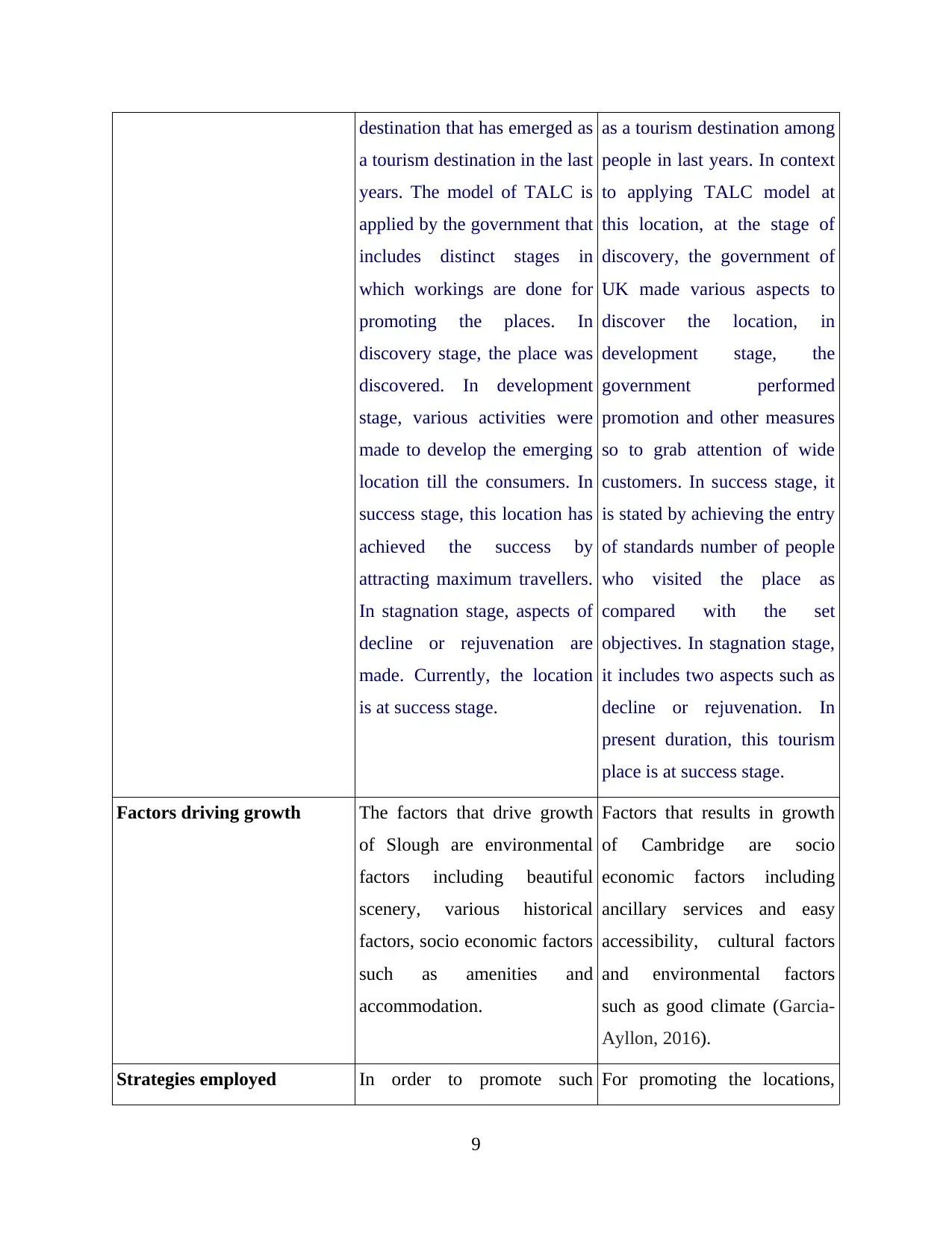
destination that has emerged as
a tourism destination in the last
years. The model of TALC is
applied by the government that
includes distinct stages in
which workings are done for
promoting the places. In
discovery stage, the place was
discovered. In development
stage, various activities were
made to develop the emerging
location till the consumers. In
success stage, this location has
achieved the success by
attracting maximum travellers.
In stagnation stage, aspects of
decline or rejuvenation are
made. Currently, the location
is at success stage.
as a tourism destination among
people in last years. In context
to applying TALC model at
this location, at the stage of
discovery, the government of
UK made various aspects to
discover the location, in
development stage, the
government performed
promotion and other measures
so to grab attention of wide
customers. In success stage, it
is stated by achieving the entry
of standards number of people
who visited the place as
compared with the set
objectives. In stagnation stage,
it includes two aspects such as
decline or rejuvenation. In
present duration, this tourism
place is at success stage.
Factors driving growth The factors that drive growth
of Slough are environmental
factors including beautiful
scenery, various historical
factors, socio economic factors
such as amenities and
accommodation.
Factors that results in growth
of Cambridge are socio
economic factors including
ancillary services and easy
accessibility, cultural factors
and environmental factors
such as good climate (Garcia‐
Ayllon, 2016).
Strategies employed In order to promote such For promoting the locations,
9
a tourism destination in the last
years. The model of TALC is
applied by the government that
includes distinct stages in
which workings are done for
promoting the places. In
discovery stage, the place was
discovered. In development
stage, various activities were
made to develop the emerging
location till the consumers. In
success stage, this location has
achieved the success by
attracting maximum travellers.
In stagnation stage, aspects of
decline or rejuvenation are
made. Currently, the location
is at success stage.
as a tourism destination among
people in last years. In context
to applying TALC model at
this location, at the stage of
discovery, the government of
UK made various aspects to
discover the location, in
development stage, the
government performed
promotion and other measures
so to grab attention of wide
customers. In success stage, it
is stated by achieving the entry
of standards number of people
who visited the place as
compared with the set
objectives. In stagnation stage,
it includes two aspects such as
decline or rejuvenation. In
present duration, this tourism
place is at success stage.
Factors driving growth The factors that drive growth
of Slough are environmental
factors including beautiful
scenery, various historical
factors, socio economic factors
such as amenities and
accommodation.
Factors that results in growth
of Cambridge are socio
economic factors including
ancillary services and easy
accessibility, cultural factors
and environmental factors
such as good climate (Garcia‐
Ayllon, 2016).
Strategies employed In order to promote such For promoting the locations,
9
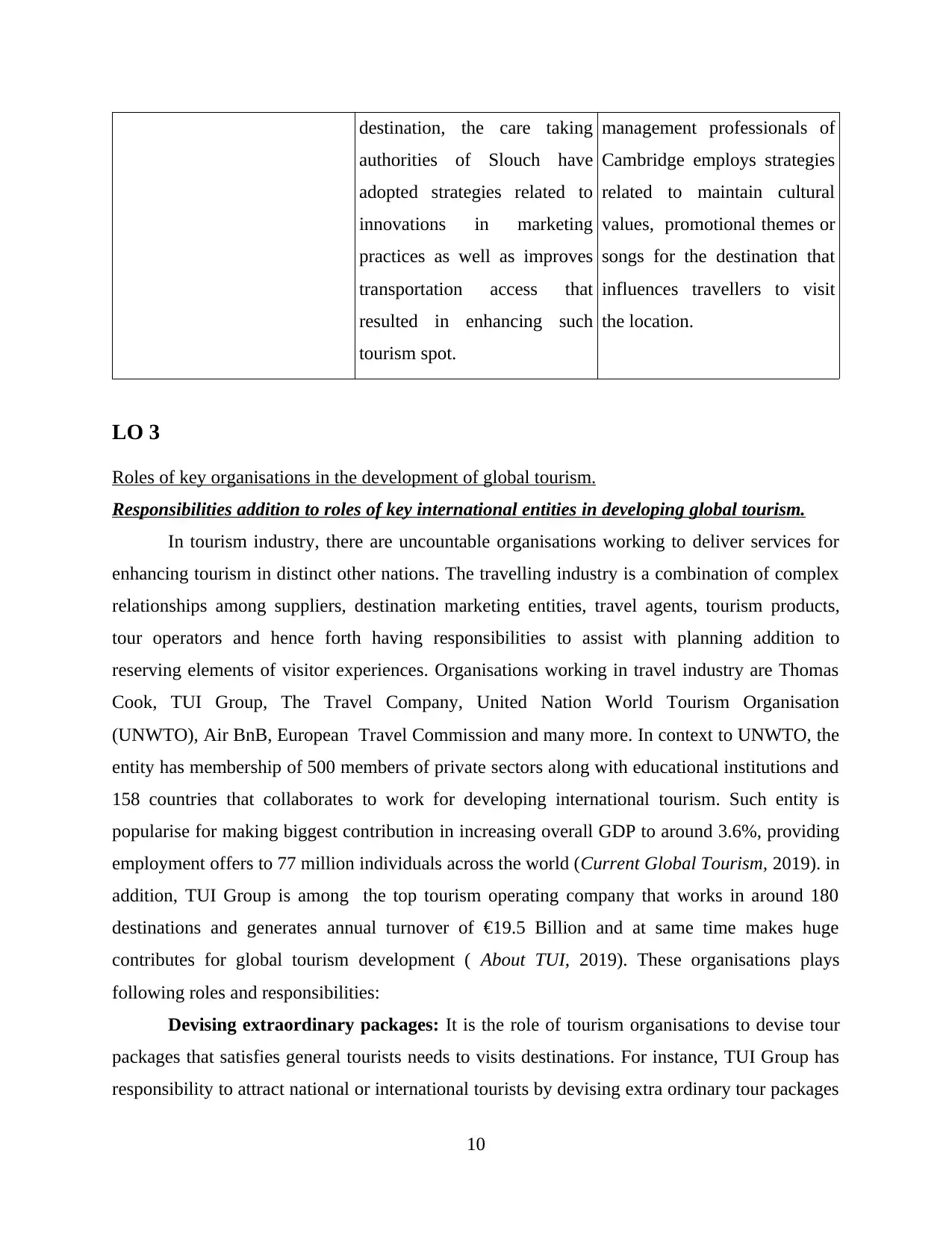
destination, the care taking
authorities of Slouch have
adopted strategies related to
innovations in marketing
practices as well as improves
transportation access that
resulted in enhancing such
tourism spot.
management professionals of
Cambridge employs strategies
related to maintain cultural
values, promotional themes or
songs for the destination that
influences travellers to visit
the location.
LO 3
Roles of key organisations in the development of global tourism.
Responsibilities addition to roles of key international entities in developing global tourism.
In tourism industry, there are uncountable organisations working to deliver services for
enhancing tourism in distinct other nations. The travelling industry is a combination of complex
relationships among suppliers, destination marketing entities, travel agents, tourism products,
tour operators and hence forth having responsibilities to assist with planning addition to
reserving elements of visitor experiences. Organisations working in travel industry are Thomas
Cook, TUI Group, The Travel Company, United Nation World Tourism Organisation
(UNWTO), Air BnB, European Travel Commission and many more. In context to UNWTO, the
entity has membership of 500 members of private sectors along with educational institutions and
158 countries that collaborates to work for developing international tourism. Such entity is
popularise for making biggest contribution in increasing overall GDP to around 3.6%, providing
employment offers to 77 million individuals across the world (Current Global Tourism, 2019). in
addition, TUI Group is among the top tourism operating company that works in around 180
destinations and generates annual turnover of €19.5 Billion and at same time makes huge
contributes for global tourism development ( About TUI, 2019). These organisations plays
following roles and responsibilities:
Devising extraordinary packages: It is the role of tourism organisations to devise tour
packages that satisfies general tourists needs to visits destinations. For instance, TUI Group has
responsibility to attract national or international tourists by devising extra ordinary tour packages
10
authorities of Slouch have
adopted strategies related to
innovations in marketing
practices as well as improves
transportation access that
resulted in enhancing such
tourism spot.
management professionals of
Cambridge employs strategies
related to maintain cultural
values, promotional themes or
songs for the destination that
influences travellers to visit
the location.
LO 3
Roles of key organisations in the development of global tourism.
Responsibilities addition to roles of key international entities in developing global tourism.
In tourism industry, there are uncountable organisations working to deliver services for
enhancing tourism in distinct other nations. The travelling industry is a combination of complex
relationships among suppliers, destination marketing entities, travel agents, tourism products,
tour operators and hence forth having responsibilities to assist with planning addition to
reserving elements of visitor experiences. Organisations working in travel industry are Thomas
Cook, TUI Group, The Travel Company, United Nation World Tourism Organisation
(UNWTO), Air BnB, European Travel Commission and many more. In context to UNWTO, the
entity has membership of 500 members of private sectors along with educational institutions and
158 countries that collaborates to work for developing international tourism. Such entity is
popularise for making biggest contribution in increasing overall GDP to around 3.6%, providing
employment offers to 77 million individuals across the world (Current Global Tourism, 2019). in
addition, TUI Group is among the top tourism operating company that works in around 180
destinations and generates annual turnover of €19.5 Billion and at same time makes huge
contributes for global tourism development ( About TUI, 2019). These organisations plays
following roles and responsibilities:
Devising extraordinary packages: It is the role of tourism organisations to devise tour
packages that satisfies general tourists needs to visits destinations. For instance, TUI Group has
responsibility to attract national or international tourists by devising extra ordinary tour packages
10
⊘ This is a preview!⊘
Do you want full access?
Subscribe today to unlock all pages.

Trusted by 1+ million students worldwide
1 out of 17
Related Documents
Your All-in-One AI-Powered Toolkit for Academic Success.
+13062052269
info@desklib.com
Available 24*7 on WhatsApp / Email
![[object Object]](/_next/static/media/star-bottom.7253800d.svg)
Unlock your academic potential
Copyright © 2020–2025 A2Z Services. All Rights Reserved. Developed and managed by ZUCOL.





